Abstract
Affecting computing is an artificial intelligence area of study that recognizes, interprets, processes, and simulates human affects. The user’s emotional states can be sensed through electroencephalography (EEG)-based Brain Computer Interfaces (BCI) devices. Research in emotion recognition using these tools is a rapidly growing field with multiple inter-disciplinary applications. This article performs a survey of the pertinent scientific literature from 2015 to 2020. It presents trends and a comparative analysis of algorithm applications in new implementations from a computer science perspective. Our survey gives an overview of datasets, emotion elicitation methods, feature extraction and selection, classification algorithms, and performance evaluation. Lastly, we provide insights for future developments.
1. Introduction
Affective computing is a branch of artificial intelligence. It is computing that relates to, arises from, or influences emotions [1]. Automatic emotion recognition is an area of study that forms part of affective computing. Research in this area is rapidly evolving thanks to the availability of affordable devices for capturing brain signals, which serve as inputs for systems that decode the relationship between emotions and electroencephalographic (EEG) variations. These devices are called EEG-based brain-computer interfaces (BCIs).
Affective states play an essential role in decision-making. Such states can facilitate or hinder problem-solving. Emotion recognition takes advantage of positive affective states, enhances emotional intelligence, and consequently improves professional and personal success [2]. Moreover, emotion self-awareness can help people manage their mental health and optimize their work performance. Automatic systems can increase our understanding of emotions, and therefore promote effective communication among individuals and human-to-machine information exchanges. Automatic EEG-based emotion recognition could also help enrich people’s relationships with their environment. Besides, automatic emotion recognition will play an essential role in artificial intelligence entities designed for human interaction [3].
According to Gartner’s 2019 Hype Cycle report on trending research topics, affective computing is at the innovation trigger stage, which is evidenced by the field’s copious publications. However, there are still no defined standards for the different components of the systems that recognize emotions using EEG signals, and it is still challenging to detect and classify emotions reliably. Thus, a survey that updates the information in the emotion recognition field, with a focus on new computational developments, is worthwhile.
This work reviews emotion recognition advances using EEG signals and BCI to (1) identify trends in algorithm usage and technology, (2) detect potential errors that must be overcome for better results, and (3) identify possible knowledge gaps in the field. The aim is to distinguish what has already been done in systems implementations and catch a glimpse of what could lie ahead. For context, our study is a survey from 2015 to 2020.
The present article gives an overview of datasets, emotion elicitation methods, feature extraction and selection, classification algorithms, and in general terms, computer intelligence techniques used in this field. We present a brief review of the components of an EEG-based system to recognize emotions and highlight trends showing statistics of their use in the literature. We deliver a compilation of papers describing new implementations, analyzing their inputs, tools, and considered classes. This up-to-date information could be used to discover and suggest new research paths.
The present survey followed the guidelines of [4]. We used Semanticscholar.org for searches of sources because it links to the major databases that contain journals and conferences proceedings. The search criteria were the keywords linked to our review’s objectives.
We extracted articles from journals and conferences that present new implementations of computational intelligence techniques. Concretely, the analyzed papers’ primary objectives were computational systems that applied algorithms for the detection and classification of emotions using EEG-based BCI devices. Such studies also included performance measures that allowed a comparison of results while taking into account the classified number of emotions.
As a result, we obtained 136 journal articles, 63 conference papers, and 15 reviews. Each whole article was read to have complete information to guide the application of inclusion and exclusion filters. The inclusion criteria were: (1) The articles were published in the considered period in peer-reviewed journals and conferences, (2) they constitute emotion recognition systems that used EEG-based BCI devices with a focus on computational intelligence applications, and (3) they include experimental setups and performance evaluations. Lastly, we applied additional exclusion criteria and eliminated review articles and other studies that have a different perspective as medical studies for diagnosis or assessment.
With these considerations, we selected 36 journal studies and 24 conference papers. From this group, we extracted statistical data about computational techniques to detect trends and perform a comparative analysis. Finally, from these 60 papers, we chose a sample of 31 articles to show a summary of technical details, components, and algorithms. It should be noted that according to generally accepted practices, 31 observations are sufficient for statistically valid conclusions due to the central limit theorem. Then, from this subsample of articles, we obtained some additional data and tendencies.
This document is organized as follows: Section 1 presents an introduction of the topic, with an overview of BCI devices, emotion representations, and correlations among brain locations, frequency bands, and affective states. Section 2 shows the structure of EEG-based BCI systems for emotion recognition. Their principal components are revised: (1) Signal acquisition, (2) preprocessing, (3) feature extraction, (4) feature selection, (5) classification, and (6) performance evaluation. Section 3 analyzes the components of our chosen research pieces and discusses trends and challenges. Section 4 presents future work. Section 5 features the conclusions or this survey.
1.1. EEG-Based BCI in Emotion Recognition
Many studies suggest that emotional states are associated with electrical activity that is produced in the central nervous system. Brain activity can be detected through its electrical signals by sensing its variations, locations, and functional interactions [5] using EEG devices. EEG signals have excellent temporal resolution and are a direct measurement of neuronal activity. These signals cannot be manipulated or simulated to fake an emotional state, so they provide reliable information. The challenge is to decode this information and map it to specific emotions.
One affordable and convenient way to detect EEG signals is through EEG-based BCI devices that are non-invasive, low cost, and even wearable, such as helmets and headbands. The development of these tools has facilitated the emergence of abundant research in the emotion recognition field.
Some scientists predict that EEG-based BCI devices will soon improve their usability. Therefore, shortly, they could be used on an everyday basis for emotion detection with several purposes, such as emotion monitoring in health care facilities, gaming and entertainment, teaching-learning scenarios, and for optimizing performance in the workplace [6], among other applications.
1.2. Emotion Representations
Emotions can be represented using different general models [7]. The most used are the discrete model and the dimensional models. The discrete model identifies basic, innate, and universal emotions from which all other emotions can be derived. Some authors state that these primary emotions are happiness, sadness, anger, surprise, disgust, and fear [8]. Some researchers consider that this model has limitations to represent specific emotions in a broader range of affective states.
Alternatively, dimensional models can express complex emotions in a two-dimensional continuous space: Valence-arousal (VA), or in three dimensions: Valence, arousal, and dominance (VAD) [9]. The VA model has valence and arousal as axes. Valence is used to rate positive and negative emotions and ranges from happy to unhappy (or sad). Arousal measures emotions from calm to stimulated (or excited). Three-dimensional models add a dominance axis to evaluate from submissive (powerless) to empowered emotions. This representation distinguishes emotions that are jointly represented in the VA model. For instance, fear and anger have similar valence-arousal representations on the VA plane. Thus, three-dimensional models improve “emotional resolution” through the dominance dimension. In this example, fear is a submissive feeling, but anger requires power [10]. Hence, the dominance dimension improves the differentiation between these two emotions.
Figure 1 shows a VA plane with the representation of basic emotions. The horizontal axis corresponds to valence dimensions, from positive to negative emotions. Likewise, the vertical axis corresponds to arousal. These two variables can be thought of as emotional state components [5]. Figure 2 presents the VAD space with a representation of the same basic emotions.
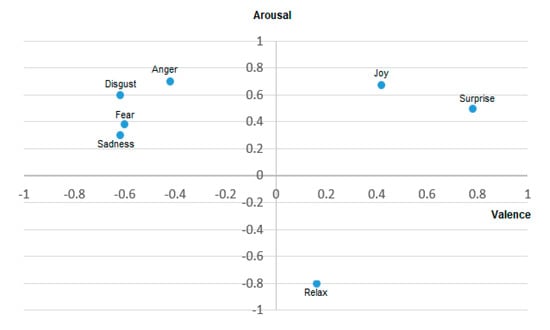
Figure 1.
Emotional states in the Valence-Arousal space [11].
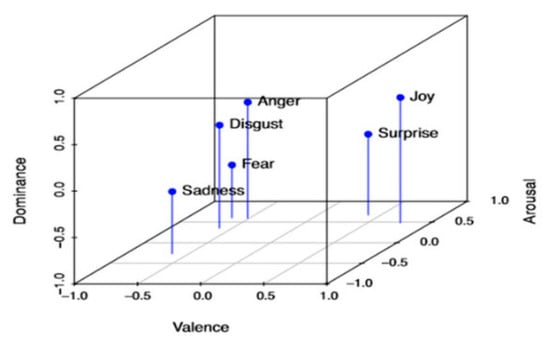
Figure 2.
Emotional states in the Valence-Arousal-Dominance space [12].
Table 1 shows that some researchers studying EEG-based functional connectivity in the brain have reported a relationship between specific brain areas and emotional states. Studies that take at-single-electrode-level analysis into account have shown that asymmetric activity at the frontal site in the alpha band is associated with emotion. Ekman and Davidson found that enjoyment generated an activation of the brain’s left frontal parts [13]. Another study found a left frontal activity reduction when volunteers adopted fear expressions [14]. Increased power in theta bands at the frontal midline is associated with pleasurable emotions, and the opposite has been observed with unpleasant feelings [15].

Table 1.
Frequency bands associations [16,17].
Several studies confirm that frequency bands are related to affective responses. However, emotions are complex processes. The authors in [15] assert that the recognition of different emotional states may be more valid if EEG-based functional connectivity is examined, rather than a single analysis at the electrode level. Correlation, coherence, and phase synchronization indices between EEG electrode pairs are used to estimate functional connectivity between different brain locations. Likewise, differential entropy (DE), and its derivatives like differential asymmetry (DASM), rational asymmetry (RASM), and differential caudality (DCAU) measure functional dissimilarities. Such features are calculated through logarithmic power spectral density for a fixed-length EEG sequence, plus the differences and ratios between DE features of hemispheric asymmetry electrodes [19].
The growing consensus seems to be that a simple mapping between emotions and specific brain structures is inconsistent with observations of different emotions activating the same structure, or one emotion activating several structures [20]. Additionally, functional connectivity between brain regions or signal complexity measures may help to detect and describe emotional states [21].
2. EEG-Based BCI Systems for Emotion Recognition
Figure 3 presents the structure of an EEG-based BCI system for emotion recognition. The processes of signal acquisition, preprocessing, feature extraction, feature selection, classification, and performance evaluation can be distinguished and will be reviewed in the following subsections.
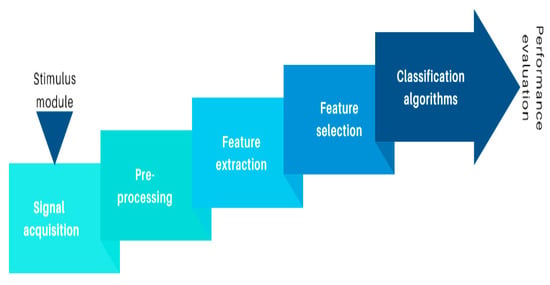
Figure 3.
Components of an EEG-based BCI for emotion recognition.
2.1. Signal Acquisition
Inexpensive wearable EEG helmets and headsets that position noninvasive electrodes along the scalp can efficiently acquire EEG signals. The clinical definition of EEG is an electrical signal recording of brain activity over time. Thus, electrodes capture signals, amplify them, and send them to a computer (or mobile device) for storage and processing. Currently, there are various low-cost EEG-based BCI devices available on the market [22]. However, many current models of EEG-based BCI become incommodious after continued use. Therefore, it is still necessary to improve their usability.
2.1.1. Public Databases
Alternatively, there are also public databases with EEG data for affective information. Table 2 presents a list of available datasets related to emotion recognition. Such datasets are convenient for research, and several emotion recognition studies use them.

Table 2.
Publicly available datasets.
2.1.2. Emotion Elicitation
The International Affective Picture System (IAPS) [31] and the International Affective Digitized Sound System (IADS) [32] are the most popular resources for emotion elicitation. These datasets provide emotional stimuli in a standardized way. Hence, it is useful for experimental investigations.
IAPS consists of 1200 images divided into 20 sets of 60 photos. Valence and arousal values are tagged for each photograph. IADS’ latest version provides 167 digitally recorded natural sounds familiar in daily life, with sounds labeled for valence, arousal, and dominance. Participants labeled the dataset using the Self-Assessment Manikin system [12]. IAPS and IADS stimuli are accessible with labeled information, which is convenient for the construction of a ground-truth for emotion assessment [33].
Other researchers used movie clips, which have also been shown capable of provoking emotions. In [34], the authors state that emotions using visual or auditory stimuli are similar. However, results obtained through affective labeling of multimedia may not be generalizable to more interactive situations or everyday circumstances. Thus, new studies using interactive emotional stimuli to ensure the generalizability of results for BCI would be welcomed.
Numerous experiments stimulated emotions in different settings, but they do not use EEG devices. However, they collected other physiological indicators as heartrate, skin galvanic changes, and respiration rate, among others. Conceptually, such paradigms could be useful if they are replicated for EEG signal acquisition. Possible experiments include stress during interviews for the detection of anger, anxiety, rejection, and depression. Exposure to odorants triggers emotions, such as anger, disgust, fear, happiness, sadness, and surprise. Harassment provokes fear. A threat of short-circuit, or a sudden backward-tilting chair elicits fear. A thread of shock provokes anxiety. Naturally, these EEG-based BCIs experiments should take into account ethical considerations.
To our knowledge, only a few studies have used more interactive conditions where participants played games or used flight simulators to induce emotions [35,36]. Alternatively, some authors have successfully used auto-induced emotions through memory recall [37].
2.1.3. Normalization
EEG signals vary widely in amplitude depending on age, sex, and other factors like changes in subjects’ alertness during the day. Hence, it is necessary to normalize measured values to deal with this variability.
There are three possible approaches to normalization. The first is to record reference conditions without stimulus on the subject. The values obtained can be normalized by subtracting the reference value, then dividing by the reference value (or subtracting the reference value), and then dividing by that same value. The second approach also requires reference conditions. Those values are included in the feature vector, which will have twice the characteristics that make up the “baseline matrix”. The third approach normalizes the data separately by obtaining a specific range, for example, between −1 and 1. This method applied to each feature independently ensures that all characteristics have the same value ranges [38,39].
The effect of normalization and its influence on the entire process of emotion recognition is not yet evident. However, some studies show that normalization allows the characteristics to be generalized so that they can be used in cross-subject emotion recognition. Tangentially, data normalization helps machine learning algorithms’ efficiency due to faster convergence.
2.2. Preprocessing
EEG signals’ preprocessing relates to signal cleaning and enhancement. EEG signals are weak and easily contaminated with noise from internal and external sources. Thus, these processes are essential to avoid noise contamination that could affect posterior classification. The body itself may produce electrical impulses through blinking, eye or muscular movement, or even heartbeats that blend with EEG signals. It should be carefully considered whether these artifacts should be removed because they may have relevant emotional state information and could improve emotion recognition algorithms’ performance. If filters are used, it is necessary to use caution to apply them to avoid signal distortions.
The three commonly used filter types in EEG are (1) low-frequency filters, (2) high-frequency filters (commonly known by electrical engineers as low-pass and high-pass filters), and (3) notch filters. The first two filters are used to filter frequencies between 1 and 50–60 Hz.
For EEG signal processing, filters, such as Butterworth, Chebyshev, or inverse Chebyshev, are preferred [39]. Each of them has specific features that need to be analyzed. A Butterworth filter has a flat response in the passband and the stopband but also has a wide transition zone. The Chebyshev filter has a ripple on the passband, and a steeper transition, so it is monotonic on the stopband. The inverse Chevishev has a flat response in the passband, is narrow in the transition, and has a ripple in the stopband. A Butterworth phase zero filter should be used to prevent a phase shift because this filter goes forward and backward over the signal to avoid this problem.
Another preprocessing objective is to clean the noise that may correspond to low-frequency signals generated by an external source, such as power line interference [40]. Notch filters are used to stop the passage of a specific frequency rather than a frequency range. This filter is designed to eliminate frequencies originated by electrical networks, and it typically ranges from 50 to 60 Hz depending on the electrical signal’s frequency in the specific country.
All of these filters are appropriate for artifact elimination in EEG signals. However, as previously noted, care must be taken when using filters. Generally, filters could distort the EEG signal’s waveform and structure in the time domain. Hence, filtering should be kept to a minimum to avoid loss of EEG signal information.
Nevertheless, preprocessing helps to separate different signals and sources. Table 3 shows methods used for preprocessing EEG signals [41] and the percentage in which they are mentioned in the literature as used from 2015 to 2020. Independent Component Analysis (ICA) and Principal Component Analysis (PCA) are tools that apply blind source analysis to isolate the source signal from noise when using multi-channel recordings so they can be used for artifact removal and noise reduction. Common Average Reference (CAR) is right for noise reduction. SL is applied for spatial filtering to improve the signal’s spatial resolution. The Common Spatial Patterns (CSP) algorithm finds spatial filters that could serve to distinguish signals corresponding to muscular movements.

Table 3.
Frequently used pre-preprocessing methods of EEG signals.
Therefore, each of the most widely used preprocessing algorithms has its benefits. In Table 3, we can observe from the percentage of the usage column that the most utilized algorithms for preprocessing are PCA (50.1%), ICA (26.8%), and CSP (17.7%).
2.3. Feature Extraction
Once signals are noise free, the BCI needs to extract essential features, which will be fed to the classifier. Features can be computed in the domain of (1) time, (2) frequency, (3) time-frequency, or (4) space, as shown in Table 4 [31,38,39]. This table presents the most popular techniques used for feature extraction, their domain, advantages, and limitations.

Table 4.
Feature extraction algorithms.
Time-domain features include the event-related potential (ERP), Hjorth features, and higher-order crossing (HOC) [58,59,60], independent component analysis (ICA), principal component analysis (PCA), and Higuchi’s fractal dimensions (FD) as a measure of signal complexity and self-similarity in this domain. There are also statistical measures, such as power, mean, standard deviation, variance, skewness, kurtosis, relative band energy, and entropy. The latter evaluates signal randomness [61].
Among frequency-domain methods, the most popular is the fast Fourier transform (FFT). Auto-regressive (AR) modeling is an alternative to Fourier-based methods for computing the frequency spectrum of a signal [62,63].
The time-frequency domain exploits variations in time and frequency, which are very descriptive of the neural activities. For this, wavelet transform (WT) and wavelet packet decomposition (WPD) are used [62].
The spatial information provided in the description of EEG signals’ characteristics is also considered in a broader approach. For this dimension, signals are referenced to digitally linked ears (DLE) values, which are calculated in terms of the left and right earlobes as follows:
where VA1 and VA2 are the reference voltages on the left and right earlobe. Thus, EEG data is broken down, considering each electrode. Consequently, each channel contains spatial information of the location pertinent to its source.
For spatial computation, the surface Laplacian (SL) algorithm reduces volume conduction effects dramatically. SL also improves EEG spatial resolution by reducing the distortion produced by volume conduction and reference electrodes [47].
Figure 4 shows EEG signals in the time domain, the frequency domain, and spatial information.
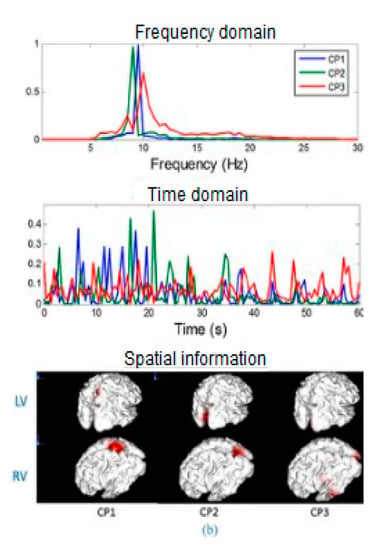
Figure 4.
Frequency domain, time domain, and spatial information [63].
According to [97], emotions emerge as the synchronization of various subsystems. Several authors use synchronized activity indexes in different parts of the brain. The efficiency of these indexes has been demonstrated in [98], calculating the correlation dimension of a group of EEG signals. In [98], other methods were used to calculate the synchronization of different areas of the brain. Synchronized indexes are a promising method for emotion recognition that deserves further research.
Table 4 shows the most commonly used algorithms and their respective mention percentages in the literature: (1) WT (26%), (2) PCA (19.7%), (3) Hjorth (17%), (4) ICA (11.3%), and (5) statistical measures (8.6%).
2.4. Feature Selection
The feature selection process is vital because it obtains the signal’s properties that best describe the EEG characteristics to be classified. In BCI systems, the feature vector generally has high dimensionality [99]. Feature selection reduces the number of input variables for the classifier (not to be confused with dimensionality reduction). While both processes decrease the data’s attributes, dimensionality reduction combines features to reduce their quantity.
A feature selection method does not change characteristics but excludes some according to specific usefulness criteria. Feature selection methods aim to achieve the best results by processing the least amount of data. It serves to remove attributes that do not contribute to the classification because they are irrelevant (or redundant) for simpler classification models (which are faster and have better performance). Additionally, feature selection methods reduce the overfitting likelihood in regular datasets, flexible models, or when the dataset has too many features but not enough observations.
One classification of feature selection methods based on the number of variables divides them into two classes: (1) Univariate and (2) multivariate. Univariate methods consider the input features one by one. Multivariate methods consider whole groups of characteristics together.
Another classification distinguishes feature selection methods as filtering, wrapper, and built-in algorithms.
- Filter methods evaluate features using the data’s intrinsic properties. Additionally, most of the filtering methods are univariate, so each feature is self-evaluated. These methods are appropriate for large data sets because they are less computationally expensive.
- Wrapping methods depend on classifier types when selecting new features based on their impact on characteristics already chosen. Only features that increase accuracy are selected.
- Built-in methods run internally in the classifier algorithms, such as deep learning. This type of process requires less computation than wrapper methods.
Examples of Feature Selection Algorithms
The following are some examples of algorithms for feature selection:
- Effect-size (ES)-based feature selection is a filter method.ES-based univariate: Cohen’s is an appropriate effect size for comparisons between two means [100]. So, if two groups’ means do not differ by 0.2 standard deviations or more, the difference is trivial, even if it is statistically significant. The effect size is calculated by taking the difference between the two groups and dividing it by the standard deviation of one of the groups. Univariate methods may discard features that could have provided useful information.ES-based multivariate helps remove several features with redundant information, therefore selecting fewer features, while retaining the most information [58]. It considers all the dependencies between characteristics when evaluating them. For example, calculating the Mahalanobis distance using the covariance structure of the noise.Min-redundancy max-relevance (mRMR) is a wrapper method [101]. This algorithm compares the mutual information between each feature with each class at the output. Mutual information between two random variables x and y is calculated as:where p (x) and p (y) are the marginal probability density functions of x and y, respectively, and p (x, y) is their joint probability function. If I (x, y) equals zero, the two random variables x and y are statistically independent [58].mRMR maximizes I (xi, y) between each characteristic xi and the target vector y; and minimizes the average mutual information I (xi, yi) between two characteristics.
- Genetic algorithms allow the dimensionality of the feature vector to be reduced using evolutionary methods, leaving only more informative feature [2,86,97].
- Stepwise discriminant analysis SDA [74]. SDA is the extension of the statistical tool for discriminant analysis that includes the stepwise technique.
- Fisher score is a feature selection technique to calculate interrelation between output classes and each feature using statistic measures [101].
Table 5 shows feature selection algorithms and their percentage of usage in the literature. Genetic algorithms are frequently used (32.3%), followed by SDA (17.7%), wrapper methods (15.6%), and mRMR (11.5%).

Table 5.
Feature selection methods used in the literature (2015–2020) in percentages (%).
2.5. Classification Algorithms
Model frameworks can categorize classification algorithms [56,57]. The model’s categories may be (1) generative-discriminative, (2) static-dynamic, (3) stable-unstable, and (4) regularized [102,103,104].
There are two different selection approaches for the classifier that works best under certain conditions in emotion recognition [56]. The first identifies the best classifier for a given BCI device. The second specifies the best classifier for a given set of features.
For synchronous BCIs, dynamic classifiers and ensemble combinations have shown better performances than SVMs. For asynchronous BCIs, the authors in this field have not determined an optimal classifier. However, it seems that dynamic classifiers perform better than static classifiers [56] because they handle better the identification of the onset of mental processes.
From the second approach, discriminative classifiers have been found to perform better than generative classifiers, principally in the presence of noise or outliers. Dynamic classifiers like SVM generally handle high dimensionality in the features better. If there is a small training set, simple techniques like LDA classifiers may yield satisfactory results [58].
2.5.1. Generative Discriminative
These classifier models generally have supervised learning problems that fit the data’s probability. A generative model specifies the distribution of each class using the joint probability distribution p(x,y) and Bayes theorem. A discriminative model finds the decision boundary between the categories using the conditional probability distribution p(y|x). Such a model includes the following classifiers: Naïve Bayes, Bayesian networks, Markov random fields, and hidden Markov models (HMM).
2.5.2. Static-Dynamic Classification
Static-dynamic classification takes into account the training method’s time variations. A static model trains the data once and then uses the trained model to classify a single feature vector. In a dynamic model, the system is updated continually. Thus, dynamic models can obtain a sequence of feature vectors and catch temporal dynamics.
Multilayer perceptron (MLP) can be considered a static classifier. Likewise, an example of a dynamic classifier is hidden Markov methods (HMM) because it can classify a sequence of feature vectors.
2.5.3. Stable Unstable
Stable classifiers usually have low complexity and do not affect their performance with small variations of the training set. For example, k Nearest Neighbors (kNN) is a common stable classifier. Unstable classifiers have high complexity and present considerable changes in performance with minor variations of the training set. Examples of unstable classifiers are linear support vector machine (SVM), multi-layer perceptron (MLP), and bilinear recurrent neural network (BLR-NN).
2.5.4. Regularized
Regularization consists of carefully controlling classifier complexity to prevent overtraining. These classifiers have excellent generalization performance. Regularized’s Fisher LDA (RF-LDA), linear SVM, and radial basis function kernel for support vector machine (RBF-SVM) are examples of regularized classifiers.
2.5.5. General Taxonomy of Classification Algorithms
Another taxonomy divides classifiers using their properties to distinguish them into general types of algorithms as linear, neural networks, nonlinear Bayesian, nearest neighbor classifiers, and combinations of systems (ensemble). Most of the more specialized algorithms can be generated from these general types. Table 6 shows this taxonomy criterion with five different categories of general classifiers: (1) Linear, (2) neural networks, (3) nonlinear Bayesian, (4) nearest neighbor classifiers, and (5) combinations of classifiers or ensemble [44,56,58].

Table 6.
Categories of general classifiers.
All general classifiers have characteristics of each of the previously mentioned framework models. For instance, SVM is discriminant, static, stable, and regularized; HMM is generative, dynamic, unstable, and not regularized; and kNN is discriminant, static, stable, and not regularized.
Consequently, the suggested guidelines for classifier selection are also applicable in this categorization. Table 6 presents the usage statistics of these classifiers in the 2015–2020 literature. The following are the most noteworthy classifiers: Neural networks CNN (46.16%), Linear classifiers SVM (30.3%), and LDA (5.5%), Nearest Neighbors kNN (4.5%), and Ensembled classifier AdaBoost (3.9%).
2.6. Performance Evaluation
Results must be reported consistently so that different research groups can understand and compare them. Hence, evaluation procedures need to be chosen and described accurately [119]. The evaluation of the classifier’s execution involves addressing performance measures, error estimation, and statistical significance testing [120]. Performance measures and error estimation configure the fulfillment rate of the classifier’s function. The most recommended performance evaluation measures are shown in Table 7. They are confusion matrix, accuracy, error rating, and other measures obtained from the confusion matrix, such as the recall, specificity, precision, Area Under the Curve (AUC), and F-measure. Other performance evaluation coefficients are Cohen’s kappa (k) [121], information transfer rate (ITR) [65], and written symbol rate (WSR) [121].

Table 7.
Conventional performance evaluation methods for BCI.
Performance evaluation and error estimation may need to be complemented with a significance evaluation. This is because high accuracies can be of little impact if the sample size is too small, or classes are imbalanced (labeled EEG signals typically are). Therefore, significance classification is essential. There are general approaches that can handle arbitrary class distributions to verify accuracy values that lie significantly above certain levels. Used methods are the theoretical level of random classification and adjusted Wald confidence interval for classification accuracy.
The theoretical level of random classification test classification results for randomness is the sum of the products between the experimental results’ classification probability and the probability calculated if all the categorization randomly occurs (p0 = classification accuracy of a random classifier). This approach can only be used after the classification has been performed [122].
Adjusted Wald confidence interval gives the lower and upper confidence limits for the probability of the correct classification, which specifies the intervals for the classifier performance evaluation index [123].
3. Literature Review of BCI Systems that Estimate Emotional States
In recent years, several research papers have been published in emotion recognition using BCI devices for data capture. Such publications use different models and strategies that produce a wide range of frameworks. Table 8 offers a summary of the research in this field from 2015 to 2020.

Table 8.
Summary of emotion recognition systems using BCI 1.
The following components characterize the systems presented in Table 8: (1) Stimulus type; (2) databases, generated by the paper’s authors or publicly available; (3) the number of participants; (4) extraction and selection of characteristics; (5) features; (6) classification algorithms; (7) number and types of classes; and (8) performance evaluation.
The applied preprocessing methods are mostly similar in the reviewed studies. Their primary preprocessing methods are standard, so this information was omitted in Table 8.
3.1. Emotion Elicitation Methods
This article analyzes research papers that used different resources to provoke emotions in their subjects. These stimuli are music videos, film clips, music tracks, self-induced disgust (produced by remembering an unpleasant odor), and risky situations in a flight simulator as an example of active elicitation of emotions. EEG-based BCI systems frequently use the public DEAP and SEED databases that apply music videos and film clips as stimuli, respectively. Different stimuli provoke emotions that affect different areas of the brain and produce EEG signals that can be recognized concerning specific emotions. Figure 5 shows the frequency in which different emotion elicitation methods are applied to generate datasets used in the reviewed systems.
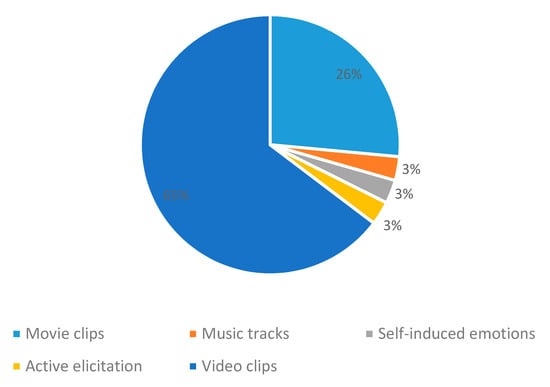
Figure 5.
Emotion elicitation methods.
Few research papers resort to more elaborate platforms to provoke “real life” emotions. However, such methods have been applied to other physiological responses (other than EEG like skin conductance, respiration, electrocardiogram (ECG), facial expressions, among others) [124]. Some authors state that stimuli that provoke wide-ranging emotions could make it challenging to explore the brain’s mechanisms activated for specific emotion generation. In this sense, focusing on a particular emotion could improve our understanding of such mechanisms. For our research sample, we highlighted research pieces that study emotions, such as dislike, and disgust separately [37,125].
3.2. Number of Participants to Generate the System Dataset
Figure 6 presents the number of participants in the experiments to obtain EEG datasets to train and test the emotion recognition systems. Most of the systems used a number of subjects in a range from 31–40 (53%), and 11–20 (31%). The targeted studies used EEG data from healthy individuals.
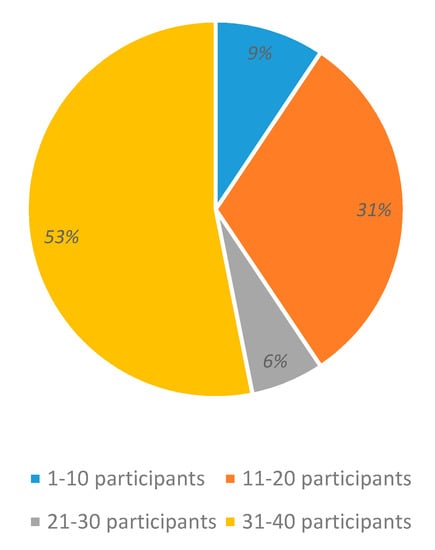
Figure 6.
Number of participants in EEG datasets.
3.3. Datasets
Figure 7 presents the usage percentage of datasets used in emotion recognition. DEEP and SEED are publicly available databases, and are the most frequently used (49% and 23% of applications, respectively). Sometimes, other studies used self-generated datasets (23%), which are typically not freely accessible. The MAHNOB-HCI and RCLS public datasets appeared in our research sample, with a participation of 3% each.
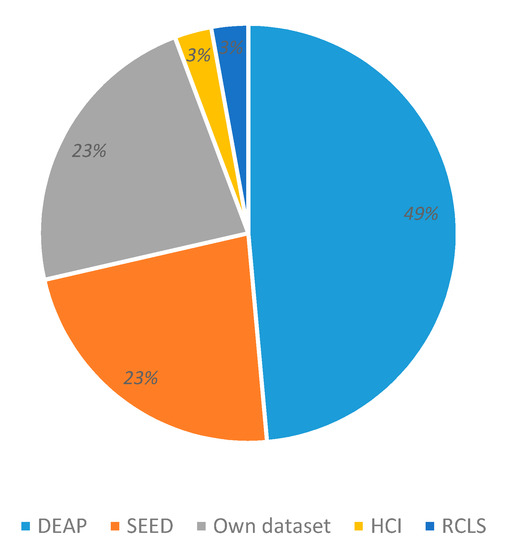
Figure 7.
EEG datasets for emotion recognition.
Systems that use public databases offer some comparability, but contrast is limited even if the same characteristics are handled. Still, such public databases could eventually lead to findings if objective comparisons are performed.
3.4. Feature Extraction
Most systems use feature extraction methods in the time, frequency, time-frequency, or space domains. A small percentage of works evaluate the functional connectivity (or differences) in the observed activity between brain regions when emotions are provoked. Features with non-redundant information combined from different domains yield better classification results. However, it is still unclear if features work better alone or in combination with each other, or which type of features are more relevant for emotion recognition.
In our review, we found that researchers addressed these issues through the development of feature extraction algorithms that outperform the classic frequency bands and extract as much information as possible from brain signals. We believe that further developments should be connected to a comprehensive understanding of the brain’s neurophysiology.
Figure 8 presents the domains of the used features. Frequency domain features are the most frequently used, and appear nearly twice as often as time domain or time-frequency domain features. Asymmetry characteristics between electrode pairs (by each hemisphere) are increasingly being used—likewise, electrodes’ location data in different brain sections. Additionally, raw data (without features) is used as inputs for deep learning classifiers.
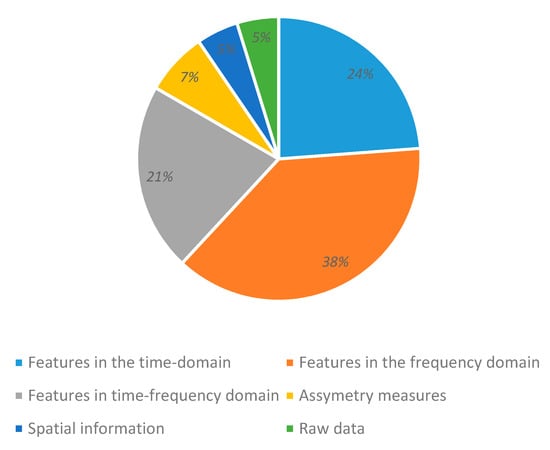
Figure 8.
Domain of used features.
Figure 9 shows the usage percentage of various algorithms for feature extraction computed in the 31 papers shown in Table 8. We found that FFT, SFFT, and DFT are the most commonly used tools for characteristic extraction in the frequency domain (27.9%). AR is used less frequently to estimate the spectrum (4.7%). WT and DWT appear in 23.3% of the systems in our sample. These algorithms are applied to obtain features in the time-frequency domain. Likewise, data from channel or electrode specific locations are less frequent (4.7%). Researchers also use statistics and computed parameters in the time domain (9.3%), normalized mutual information NMI (2.3%), ERS (2.3%), and ERD (2.3%).
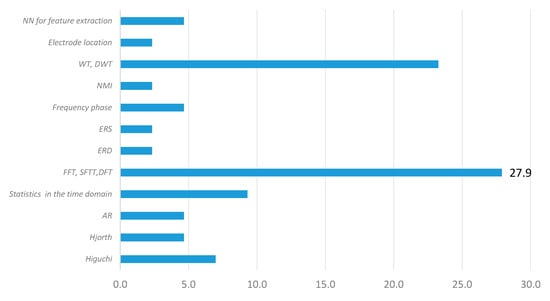
Figure 9.
Percentage of the use of algorithms for feature extraction from Table 8.
We observed an increasing presence of algorithms embedded in neural networks like RBN, DBN, TensorFlow functions, and LSTM (4.7%) that are used to extract signal features automatically from raw data. This approach yields a good enough classifier performance, probably because it preserves information and avoids the risk of removing essential emotion-related signal features.
3.5. Feature Selection
It is worth noting that 61.3% of the systems presented in Table 8 do not use a feature selection method. Table 9 lists the systems that utilized feature selection algorithms. Interestingly, virtually every system uses a different algorithm except for the methods minimum redundancy maximum relevance (mRMR) and recursive feature elimination, which are utilized for two different schemes.

Table 9.
Systems in Table 8 using feature selection algorithms.
3.6. Classifiers
Figure 10 shows that most classifiers were linear (48%) and neural networks (41%); a few papers used nearest neighbors (7%) and ensemble methods (5%). Consequently, it is worth mentioning that the following algorithms have become increasingly popular for EEG-based emotion recognition applications:
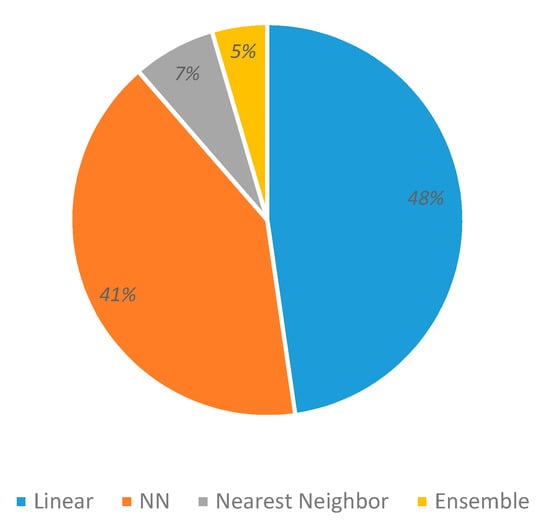
Figure 10.
Classifiers’ usage.
- Linear classifiers, such as naïve Bayes (NB), logistic regression (LR), support vector machine (SVM), linear discriminant analysis (LDA) (48% of use); and
- Neural networks like multi-layer perceptron (MLP), radial basis function RBF, convolutional neural network (CNN), deep belief networks (DBN), extreme learning method (ELM), graph regularized extreme learning machine (GELM), long short term memory (LSTM), domain adversarial neural network (DANN), Caps Net, and graph regularized sparse linear regularized (GRSLR) (41% of use).
- Ensemble classifiers like random forest, CART, bagging tree, Adaboost, and XGBoost are less used (5%). The same situation occurs with the kNN algorithm despite their consistently good performance results, probably because it works better with a simpler feature vector (7%).
During our considered period, this review did not find studies that applied non-linear Bayesian classifiers as hidden Markov models (HMM).
3.7. Performance vs. the Number of Classes-Emotions
The performance of almost all systems was evaluated using accuracy, except for two systems in which one used area under the curve (AUC), and the other one presented an F1 measure. Unfortunately, EEG datasets are usually unbalanced, with one or two labeled emotions more numerous than the others, which is somewhat problematic for this approach. Thus, this situation could lead to biased classifications. Moreover, EEG datasets are typically unbalanced, and performance measures should be calculated to contextualize their outcomes. In our view, this is why such results are not entirely comparable among different studies.
In Figure 11, we present the relationship between systems and the number of classified emotions. Most systems use the VA or VAD spaces and classify each dimension as a bi-class (for instance, valence positive and negative; arousal high-value and low value) or tri-class problem (for example, valence positive, neutral, and negative; arousal and dominance high-value and low-value).
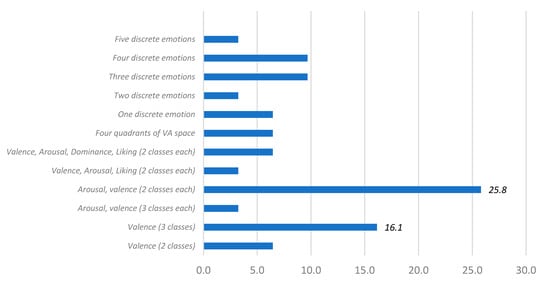
Figure 11.
Percentage of systems with different numbers of classified emotions.
Arousal and valence have the highest usage percentages (25.8%). On the other hand, 16.1% categorized valence with three classes: Positive, neutral, and negative. Then, 9.7% classified three discrete emotions like sadness, love, and anger. Moreover, lastly, 6.5% ranked valence as two classes (positive and negative), four discrete emotions (happy, sad, fear, and relaxed), one discrete emotion (disgust), or emotions located in one of four quadrants of the VA space (high valence-high arousal, high valence–low arousal, low valence–high arousal, and low valence–low arousal).
Classifier performance should be evaluated, taking into account that accuracy would be inversely proportional to the number of detected emotions. In other words, classification accuracy should be higher than a random classification process (equal chance for each class). Thus, as classification classes increase, a random classification process would yield a lower accuracy. For instance, a two-class random classification process would be 50% accurate. Likewise, three classes would imply a 33% classification accuracy for a random classification process, and so on. Therefore, such accuracy metrics should provide the classification performance benchmark for our evaluations.
Although the results of the performance of the systems depend on many factors, it is possible to find some relationship between the number of classes, the type of emotions classified, and the accuracy obtained (Figure 12). The best results are obtained with two classes, either as discrete emotions or as positive or negative values in a dimensional space. The second-best value is found for the recognition of one negative discrete emotion like dislike or disgust. The result that the classification of one emotion does not obtain the best performance value could be explained by the fact that in our review, we observed that negative emotions are more challenging to classify and tend to yield smaller performance values.
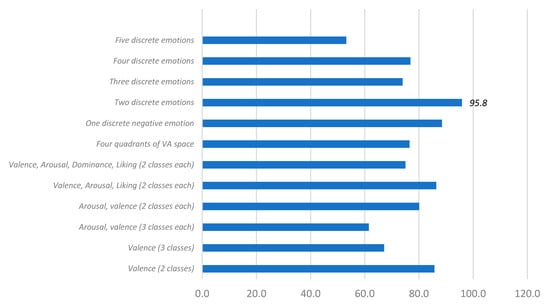
Figure 12.
Accuracy vs. types and number of classified emotions.
Comparing approaches and results obtained through different BCI-based systems is complex. This is because each system uses diverse experimental methods for emotion elicitation, protocols to detect EEG signals, datasets, extraction and selection of features, classification algorithms, and generally speaking, each implementation has different settings. Ideally, systems should be tested under similar conditions, but that scenario is not yet available. However, we can perform a comparative analysis to extract trends, bearing in mind such limitations.
4. Future Work
Datasets developed for specific applications use passive methods to provoke emotions, such as IAPS, IADS, music videos, and film clips. Public databases, such as DEAP and SEED, use emotion elicitation through music videos and film clips, respectively. Few studies implement active emotion methods for provoking emotions, such as video games and flight simulators.
Going forward, we expect the generation of datasets that use active elicitation methods because these techniques simulate “real life” events better, and are more efficient at emotion induction. However, the implementation of such types of studies requires a significantly more complex experimental setup.
Furthermore, the study of individual emotions has been recently trending. Some works include fear detection, an analysis that has applications in phobia investigation, and other psychiatric disorders. It is worth mentioning that our survey found that negative emotions are more challenging to detect than positive ones.
We did not find in the literature the EEG-based emotion recognition of mixed feelings that combine positive and negative affects sensed at the same moment, for instance, bittersweet feelings. These mixed emotions are interesting because they are related to the study of higher creative performance [141].
Feature extraction and selection are EEG-based BCI system components, which are continuously evolving. They should be designed based on a profound understanding of the brain’s biology and physiology. The development of novel features is a topic that can contribute significantly to the improvement of results for emotion recognition systems. For instance, time-domain features are combined with frequency, time-frequency characteristics, channel location, and connectivity criteria. The development of novel feature extraction methods includes asymmetry discoveries in different functioning brain segments, new electrode locations that provide more information, connectivity models (between channels), and correlations needed for understanding functionality.
These evolving features contend that EEG signals and their frequency bands are related to multiple functional and connectivity considerations. The study of the relationship between EEG and biological or psycho-emotional elements should improve going forward. Improved features could better capture individual emotion dynamics and also correlate characteristics across individuals and sessions.
A particularly interesting trend in feature extraction is to use deep neural networks. These systems receive raw data to avoid loss of information and take advantage of the neural networks functioning to obtain relevant features automatically.
The overall reported system accuracy results range from 53% to 90% for the classification of one or more emotions. However, there likely is a gap between real-world applications performed in real time, which presents enormous challenges compared to experiments conducted in a laboratory. Some authors suggest that training datasets should be generated on a larger scale to overcome those challenges. Indeed, we believe it is reasonable that larger datasets could catalyze the research in this field. It is worth mentioning that a similar dynamic played out in the area of image recognition, which experienced a rapid expansion due to the generation of massive databases. Nevertheless, this effort for EEG datasets would likely require collaboration between various research groups to achieve emotions triggered by active elicitation methods.
Overall, we believe systems should be trained with larger sample sizes (and samples per subject), plus the use of real-time data. With such improved datasets, unsupervised techniques could be implemented to obtain comprehensive models. Moreover, these robust systems might allow for transfer learning, i.e., general models that can be applied successfully to particular individuals.
5. Conclusions
EEG signals are reliable information that cannot be simulated or faked. To decode EEG and relate these signals to specific emotion is a complex problem. Affective states do not have a simple mapping with specific brain structures because different emotions activate the same brain locations, or conversely, a single emotion can activate several structures.
In recent years, EEG-based BCI emotion recognition has been a field affecting computing that has generated much interest. Significant advances in the development of low-cost BCI devices with increasingly better usability have encouraged numerous research studies.
In this article, we reviewed the different algorithms and processes that can be part of EEG-based BCI emotion recognition systems: (1) Emotion elicitation, (2) signal acquisition, (3) feature extraction and selection, (4) classification techniques, and (5) performance evaluation. For our survey of this topic, we mined different databases and selected 60 studies carried out under a computer science perspective to gain insight into state of the art and suggest possible future research efforts.
As seen in this review, computational methods still do not have standards for various applications. Researchers continuing to look for new solutions in an ongoing effort. The study of the relationship between brain signals and emotions is a complex problem, and novel methods and new implementations are continuously presented. We expect that many of the existing challenges will soon be solved and will pave the way for a vast area of possible applications using EEG-based emotion recognition.
Author Contributions
Conceptualization and Investigation as part of his Ph.D. research, E.P.T.; E.A.T., M.H.-Á., and S.G.Y. contributed with overall supervision, review editing. All authors have read and agreed to the published version of the manuscript.
Funding
Escuela Politécnica Nacional funded the publication of this article.
Conflicts of Interest
The authors declare no conflict of interest.
References
- Picard, R.W. Affective Computing for HCI. In Proceedings of the HCI International 1999-Proceedings of the 8th International Conference on Human-Computer Interaction, Munich, Germany, 22–26 August 1999. [Google Scholar]
- Elfenbein, H.A.; Ambady, N. Predicting workplace outcomes from the ability to eavesdrop on feelings. J. Appl. Psychol. 2002, 87, 963–971. [Google Scholar] [CrossRef] [PubMed]
- Goenaga, S.; Navarro, L.; Quintero, C.G.M.; Pardo, M. Imitating human emotions with a nao robot as interviewer playing the role of vocational tutor. Electronics 2020, 9, 971. [Google Scholar] [CrossRef]
- Kitcheman, B. Procedures for performing systematic reviews. Comput. Sci. 2004, 1–28. Available online: http://www.inf.ufsc.br/~aldo.vw/kitchenham.pdf (accessed on 26 May 2020).
- Salzman, C.D.; Fusi, S. Emotion, cognition, and mental state representation in Amygdala and prefrontal Cortex. Annu. Rev. Neurosci. 2010, 33, 173–202. [Google Scholar] [CrossRef]
- Konar, A.; Chakraborty, A. Emotion Recognition: A Pattern Analysis Approach; John Wiley & Sons: Hoboken, NJ, USA, 2015; ISBN 9781118910566. [Google Scholar]
- Panoulas, K.J.; Hadjileontiadis, L.J.; Panas, S.M. Brain-Computer Interface (BCI): Types, Processing Perspectives and Applications; Springer: Berlin/Heidelberg, Germany, 2010; pp. 299–321. [Google Scholar]
- Ekman, P. Ekman 1992.pdf. Psychol. Rev. 1992, 99, 550–553. [Google Scholar] [CrossRef] [PubMed]
- Verma, G.K.; Tiwary, U.S. Affect representation and recognition in 3D continuous valence–arousal–dominance space. Multimed. Tools Appl. 2017, 76, 2159–2183. [Google Scholar] [CrossRef]
- Bălan, O.; Moise, G.; Moldoveanu, A.; Leordeanu, M.; Moldoveanu, F. Fear level classification based on emotional dimensions and machine learning techniques. Sensors 2019, 19, 1738. [Google Scholar] [CrossRef] [PubMed]
- Russell, J.A. A circumplex model of affect. J. Pers. Soc. Psychol. 1980, 39, 1161. [Google Scholar] [CrossRef]
- Bradley, M.M.; Lang, P.J. Measuring emotion: The self-assessment manikin and the semantic differential. J. Behav. Ther. Exp. Psychiatry 1994, 25, 49–59. [Google Scholar] [CrossRef]
- Ekman, P.; Davidson, R.J. Voluntary smiling changes regional brain activity. Psychol. Sci. 1993, 4, 342–345. [Google Scholar] [CrossRef]
- Bhatti, A.M.; Majid, M.; Anwar, S.M.; Khan, B. Human emotion recognition and analysis in response to audio music using brain signals. Comput. Human Behav. 2016, 65, 267–275. [Google Scholar] [CrossRef]
- Lee, Y.Y.; Hsieh, S. Classifying different emotional states by means of eegbased functional connectivity patterns. PLoS ONE 2014, 9, e95415. [Google Scholar] [CrossRef]
- Zheng, W.L.; Guo, H.T.; Lu, B.L. Revealing critical channels and frequency bands for emotion recognition from EEG with deep belief network. Int. IEEE/EMBS Conf. Neural Eng. NER 2015, 2015, 154–157. [Google Scholar] [CrossRef]
- Knyazev, G.G.; Slobodskoj-Plusnin, J.Y. Behavioural approach system as a moderator of emotional arousal elicited by reward and punishment cues. Pers. Individ. Dif. 2007, 42, 49–59. [Google Scholar] [CrossRef]
- Kirmizi-Alsan, E.; Bayraktaroglu, Z.; Gurvit, H.; Keskin, Y.H.; Emre, M.; Demiralp, T. Comparative analysis of event-related potentials during Go/NoGo and CPT: Decomposition of electrophysiological markers of response inhibition and sustained attention. Brain Res. 2006, 1104, 114–128. [Google Scholar] [CrossRef]
- Hyvarinen, A. New Approximations of differential entropy for independent component analysis and projection pursuit. In Proceedings of the Advances in Neural Information Processing Systems, Denver, CO, USA; 1998; pp. 273–279. [Google Scholar]
- Hamann, S. Mapping discrete and dimensional emotions onto the brain: Controversies and consensus. Trends Cogn. Sci. 2012, 16, 458–466. [Google Scholar] [CrossRef]
- Davidson, R.J.; Ekman, P.; Saron, C.D.; Senulis, J.A.; Friesen, W.V. Approach-withdrawl-and-cerebral-asymmetry-emotional-expres davidson 1990.pdf. J. Pers. Soc. Psychol. 1990, 58, 330–341. [Google Scholar] [CrossRef]
- Peterson, V.; Galván, C.; Hernández, H.; Spies, R. A feasibility study of a complete low-cost consumer-grade brain-computer interface system. Heliyon 2020, 6. [Google Scholar] [CrossRef]
- Savran, A.; Ciftci, K.; Chanel, G.; Mota, J.C.; Viet, L.H.; Sankur, B.; Akarun, L.; Caplier, A.; Rombaut, M. Emotion detection in the loop from brain signals and facial images. eNTERFACE 2006, 6, 69–80. [Google Scholar]
- Onton, J.; Makeig, S. High-frequency broadband modulations of electroencephalographic spectra. Front. Hum. Neurosci. 2009, 3, 1–18. [Google Scholar] [CrossRef]
- Yadava, M.; Kumar, P.; Saini, R.; Roy, P.P.; Prosad Dogra, D. Analysis of EEG signals and its application to neuromarketing. Multimed. Tools Appl. 2017, 76, 19087–19111. [Google Scholar] [CrossRef]
- Zheng, W.L.; Liu, W.; Lu, Y.; Lu, B.L.; Cichocki, A. EmotionMeter: A Multimodal framework for recognizing human emotions. IEEE Trans. Cybern. 2019, 49, 1110–1122. [Google Scholar] [CrossRef] [PubMed]
- Soleymani, M.; Lichtenauer, J.; Pun, T.; Pantic, M. A multimodal database for affect recognition and implicit tagging. IEEE Trans. Affect. Comput. 2012, 3, 42–55. [Google Scholar] [CrossRef]
- Grégoire, C.; Rodrigues, P.L.C.; Congedo, M. EEG Alpha Waves Dataset; Centre pour la Communication Scientifique Directe: Grenoble, France, 2019. [Google Scholar]
- Katsigiannis, S.; Ramzan, N. DREAMER: A database for emotion recognition through EEG and ECG signals from wireless low-cost off-the-shelf devices. IEEE J. Biomed. Heal. Informatics 2018, 22, 98–107. [Google Scholar] [CrossRef]
- Li, Y.; Zheng, W.; Cui, Z.; Zong, Y.; Ge, S. EEG emotion recognition based on graph regularized sparse linear regression. Neural Process. Lett. 2019, 49, 555–571. [Google Scholar] [CrossRef]
- Lang, P.J.; Bradley, M.M.; Cuthbert, B.N. International affective picture system (IAPS): Technical manual and affective ratings. NIMH Cent. Study Emot. Atten. 1997, 1, 39–58. [Google Scholar]
- Yang, W.; Makita, K.; Nakao, T.; Kanayama, N.; Machizawa, M.G.; Sasaoka, T.; Sugata, A.; Kobayashi, R.; Hiramoto, R.; Yamawaki, S.; et al. Affective auditory stimulus database: An expanded version of the International Affective Digitized Sounds (IADS-E). Behav. Res. Methods 2018, 50, 1415–1429. [Google Scholar] [CrossRef]
- Mühl, C.; Allison, B.; Nijholt, A.; Chanel, G. A survey of affective brain computer interfaces: Principles, state-of-the-art, and challenges. Brain Comput. Interfaces 2014, 1, 66–84. [Google Scholar] [CrossRef]
- Zhou, F.; Qu, X.; Jiao, J.; Helander, M.G. Emotion prediction from physiological signals: A comparison study between visual and auditory elicitors. Interact. Comput. 2014, 26, 285–302. [Google Scholar] [CrossRef]
- Pallavicini, F.; Ferrari, A.; Pepe, A.; Garcea, G. Effectiveness of virtual reality survival horror games for the emotional elicitation: Preliminary insights using Resident Evil 7: Biohazard. In International Conference on Universal Access in Human-Computer Interaction; Springer: Cham, Switzerland, 2018. [Google Scholar] [CrossRef]
- Roza, V.C.C.; Postolache, O.A. Multimodal approach for emotion recognition based on simulated flight experiments. Sensors 2019, 19, 5516. [Google Scholar] [CrossRef] [PubMed]
- Iacoviello, D.; Petracca, A.; Spezialetti, M.; Placidi, G. A real-time classification algorithm for EEG-based BCI driven by self-induced emotions. Comput. Methods Programs Biomed. 2015, 122, 293–303. [Google Scholar] [CrossRef] [PubMed]
- Novak, D.; Mihelj, M.; Munih, M. A survey of methods for data fusion and system adaptation using autonomic nervous system responses in physiological computing. Interact. Comput. 2012, 24, 154–172. [Google Scholar] [CrossRef]
- Bustamante, P.A.; Lopez Celani, N.M.; Perez, M.E.; Quintero Montoya, O.L. Recognition and regionalization of emotions in the arousal-valence plane. In Proceedings of the 2015 Milano, Italy 37th Annual International Conference of the IEEE Engineering in Medicine and Biology Society (EMBC), Milano, Italy, 25–29 August 2015; Volume 2015, pp. 6042–6045. [Google Scholar]
- Sanei, S.; Chambers, J.A. EEG Signal Processing; John Wiley & Sons: Hoboken, NJ, USA, 2013; ISBN 9780470025819. [Google Scholar]
- Abhang, P.A.; Suresh, C.; Mehrotra, B.W.G. Introduction to EEG-and Speech-Based Emotion Recognition; Elsevier: Amsterdam, The Netherlands, 2016; ISBN 9780128044902. [Google Scholar]
- Jardim-Gonçalves, R.; Universidade Nova de Lisboa. Faculdade de Ciências e Tecnologia; Institute of Electrical and Electronics Engineers; IEEE Technology Engineering and Management Society. In Proceedings of the IEEE International Technology Management Conference, Madeira Islands, Portugal, 27–29 June 2017; International Conference on Engineering, Technology and Innovation (ICE/ITMC) : “Engineering, technology & innovation management beyond 2020: New challenges, new approaches” : Conference proceedings. ISBN 9781538607749. [Google Scholar]
- Alhaddad, M.J.; Kamel, M.; Malibary, H.; Thabit, K.; Dahlwi, F.; Hadi, A. P300 speller efficiency with common average reference. Lect. Notes Comput. Sci. 2012, 7326 LNAI, 234–241. [Google Scholar] [CrossRef]
- Alhaddad, M.J.; Kamel, M.; Malibary, H.; Thabit, K.; Dahlwi, F.; Hadi, A. P300 speller efficiency with common average reference. In Proceedings of the International Conference on Autonomous and Intelligent Systems, Aveiro, Portugal, 25–27 June 2012; pp. 234–241. [Google Scholar]
- Murugappan, M.; Nagarajan, R.; Yaacob, S. Combining spatial filtering and wavelet transform for classifying human emotions using EEG Signals. J. Med. Biol. Eng. 2011, 31, 45–51. [Google Scholar] [CrossRef]
- Murugappan, M.; Murugappan, S. Human emotion recognition through short time Electroencephalogram (EEG) signals using Fast Fourier Transform (FFT). In Proceedings of the Proceedings-2013 IEEE 9th International Colloquium on Signal Processing and its Applications, Kuala Lumpur, Malaysia, 8–10 March 2013; pp. 289–294. [Google Scholar]
- Burle, B.; Spieser, L.; Roger, C.; Casini, L.; Hasbroucq, T.; Vidal, F. Spatial and temporal resolutions of EEG: Is it really black and white? A scalp current density view. Int. J. Psychophysiol. 2015, 97, 210–220. [Google Scholar] [CrossRef]
- Mazumder, I. An analytical approach of EEG analysis for emotion recognition. In Proceedings of the 2019 Devices for Integrated Circuit (DevIC), Kalyani, India, 23 March 2019; pp. 256–260. [Google Scholar] [CrossRef]
- Subasi, A.; Gursoy, M.I. EEG signal classification using PCA, ICA, LDA and support vector machines. Expert Syst. Appl. 2010, 37, 8659–8666. [Google Scholar] [CrossRef]
- Lee, H.; Choi, S. Pca + hmm + svm for eeg pattern classification. In Proceedings of the Seventh International Symposium on Signal Processing and Its Applications, Paris, France, 4 July 2003; pp. 541–544. [Google Scholar]
- Doma, V.; Pirouz, M. A comparative analysis of machine learning methods for emotion recognition using EEG and peripheral physiological signals. J. Big Data 2020, 7. [Google Scholar] [CrossRef]
- Shaw, L.; Routray, A. Statistical features extraction for multivariate pattern analysis in meditation EEG using PCA. In Proceedings of the 2016 IEEE EMBS International Student Conference ISC, Ottawa, ON, Canada, 31 May 2016; pp. 1–4. [Google Scholar] [CrossRef]
- Symposium, I.; Analysis, I.C.; Separation, B.S. 4th International Symposium on Independent Component Analysis and Blind Signal Separation (ICA2003), April 2003, Nara, Japan. Analysis 2003, 975–980. [Google Scholar]
- Liu, J.; Meng, H.; Li, M.; Zhang, F.; Qin, R.; Nandi, A.K. Emotion detection from EEG recordings based on supervised and unsupervised dimension reduction. Concurr. Comput. 2018, 30, 1–13. [Google Scholar] [CrossRef]
- Yong, X.; Ward, R.K.; Birch, G.E. Robust common spatial patterns for EEG signal preprocessing. In Proceedings of the 30th Annual International Conference of the IEEE Engineering in Medicine and Biology Society, EMBS’08-“Personalized Healthcare through Technology”, Boston, MA, USA, 30 August 2011; pp. 2087–2090. [Google Scholar]
- Li, X.; Fan, H.; Wang, H.; Wang, L. Common spatial patterns combined with phase synchronization information for classification of EEG signals. Biomed. Signal Process. Control 2019, 52, 248–256. [Google Scholar] [CrossRef]
- Interfaces, B. A Tutorial on EEG signal processing techniques for mental state recognition in brain-computer interfaces. Guid. Brain Comput. Music Interfacing 2014. [Google Scholar] [CrossRef]
- Jenke, R.; Peer, A.; Buss, M. Feature extraction and selection for emotion recognition from EEG. IEEE Trans. Affect. Comput. 2014, 5, 327–339. [Google Scholar] [CrossRef]
- Al-Fahoum, A.S.; Al-Fraihat, A.A. Methods of EEG signal features extraction using linear analysis in frequency and time-frequency domains. ISRN Neurosci. 2014, 2014, 1–7. [Google Scholar] [CrossRef] [PubMed]
- Petrantonakis, P.C.; Hadjileontiadis, L.J. Emotion recognition from brain signals using hybrid adaptive filtering and higher order crossings analysis. IEEE Trans. Affect. Comput. 2010, 1, 81–97. [Google Scholar] [CrossRef]
- Torres, E.P.; Torres, E.A.; Hernandez-Alvarez, M.; Yoo, S.G. Machine learning analysis of EEG measurements of stock trading performance. In Advances in Artificial Intelligence, Software and Systems Engineering; Springer Nature: Lodon, UK, 2020. [Google Scholar]
- Kubben, P.; Dumontier, M.; Dekker, A. Fundamentals of clinical data science. Fundam. Clin. Data Sci. 2018, 1–219. [Google Scholar] [CrossRef]
- Karahan, E.; Rojas-Lopez, P.A.; Bringas-Vega, M.L.; Valdes-Hernandez, P.A.; Valdes-Sosa, P.A. Tensor analysis and fusion of multimodal brain images. Proc. IEEE 2015, 103, 1531–1559. [Google Scholar] [CrossRef]
- Winkler, I.; Debener, S.; Muller, K.R.; Tangermann, M. On the influence of high-pass filtering on ICA-based artifact reduction in EEG-ERP. In Proceedings of the 2015 37th Annual International Conference of the IEEE Engineering in Medicine and Biology Society (EMBC), Milan, Italy, 25–29 August 2015. [Google Scholar] [CrossRef]
- Zhang, Y.; Zhou, G.; Zhao, Q.; Jin, J.; Wang, X.; Cichocki, A. Spatial-temporal discriminant analysis for ERP-based brain-computer interface. IEEE Trans. Neural Syst. Rehabil. Eng. 2013, 21, 233–243. [Google Scholar] [CrossRef]
- Brouwer, A.M.; Zander, T.O.; Van Erp, J.B.F.; Korteling, J.E.; Bronkhorst, A.W. Using neurophysiological signals that reflect cognitive or affective state: Six recommendations to avoid common pitfalls. Front. Neurosci. 2015, 9, 1–11. [Google Scholar] [CrossRef]
- Wu, Z.; Yao, D.; Tang, Y.; Huang, Y.; Su, S. Amplitude modulation of steady-state visual evoked potentials by event-related potentials in a working memory task. J. Biol. Phys. 2010, 36, 261–271. [Google Scholar] [CrossRef][Green Version]
- Abootalebi, V.; Moradi, M.H.; Khalilzadeh, M.A. A new approach for EEG feature extraction in P300-based lie detection. Comput. Methods Programs Biomed. 2009, 94, 48–57. [Google Scholar] [CrossRef] [PubMed]
- Bhise, P.R.; Kulkarni, S.B.; Aldhaheri, T.A. Brain computer interface based EEG for emotion recognition system: A systematic review. In Proceedings of the 2020 2nd International Conference on Innovative Mechanisms for Industry Applications (ICIMIA), Bangalore, India, 5–7 March 2020; ISBN 9781728141671. [Google Scholar]
- Li, X.; Song, D.; Zhang, P.; Zhang, Y.; Hou, Y.; Hu, B. Exploring EEG features in cross-subject emotion recognition. Front. Neurosci. 2018, 12. [Google Scholar] [CrossRef] [PubMed]
- Liu, Y.; Sourina, O. EEG databases for emotion recognition. In Proceedings of the 2013 International Conference on Cyberworlds, Yokohama, Japan, 21–23 October 2013; pp. 302–309. [Google Scholar]
- Hossain, M.Z.; Kabir, M.M.; Shahjahan, M. Feature selection of EEG data with neuro-statistical method. In Proceedings of the 2013 International Conference on Electrical Information and Communication Technology (EICT), Khulna, Bangladesh, 13–15 February 2014. [Google Scholar] [CrossRef]
- Bavkar, S.; Iyer, B.; Deosarkar, S. Detection of alcoholism: An EEG hybrid features and ensemble subspace K-NN based approach. In Proceedings of the International Conference on Distributed Computing and Internet Technology, Bhubaneswar, India, 10–13 January 2019; pp. 161–168. [Google Scholar]
- Pane, E.S.; Wibawa, A.D.; Pumomo, M.H. Channel Selection of EEG Emotion Recognition using Stepwise Discriminant Analysis. In Proceedings of the 2018 International Conference on Computer Engineering, Network and Intelligent Multimedia (CENIM), Surabaya, Indonesia, 26–27 November 2018; pp. 14–19. [Google Scholar] [CrossRef]
- Musselman, M.; Djurdjanovic, D. Time-frequency distributions in the classification of epilepsy from EEG signals. Expert Syst. Appl. 2012, 39, 11413–11422. [Google Scholar] [CrossRef]
- Xu, H.; Plataniotis, K.N. Affect recognition using EEG signal. In Proceedings of the 2012 IEEE 14th International Workshop on Multimedia Signal Processing (MMSP), Banff, AB, Canada, 17 September 2012; pp. 299–304. [Google Scholar] [CrossRef]
- Wu, X.; Zheng, W.-L.; Lu, B.-L. Investigating EEG-Based Functional Connectivity Patterns for Multimodal Emotion Recognition. 2020. Available online: https://arxiv.org/abs/2004.01973 (accessed on 26 May 2020).
- Zheng, W.-L.; Zhu, J.-Y.; Lu, B.-L. Identifying Stable Patterns over Time for Emotion Recognition from EEG. IEEE Trans. Affect. Comput. 2017, 10, 417–429. [Google Scholar] [CrossRef]
- Yang, Y.; Wu, Q.M.J.; Zheng, W.L.; Lu, B.L. EEG-based emotion recognition using hierarchical network with subnetwork nodes. IEEE Trans. Cogn. Dev. Syst. 2018, 10, 408–419. [Google Scholar] [CrossRef]
- Li, P.; Liu, H.; Si, Y.; Li, C.; Li, F.; Zhu, X.; Huang, X.; Zeng, Y.; Yao, D.; Zhang, Y.; et al. EEG based emotion recognition by combining functional connectivity network and local activations. IEEE Trans. Biomed. Eng. 2019, 66, 2869–2881. [Google Scholar] [CrossRef]
- Li, Z.; Tian, X.; Shu, L.; Xu, X.; Hu, B. Emotion recognition from EEG using RASM and LSTM. In Proceedings of the International Conference on Internet Multimedia Computing and Service, Qingdao, China, 23–25 August 2017; pp. 310–318. [Google Scholar]
- Mowla, M.R.; Cano, R.I.; Dhuyvetter, K.J.; Thompson, D.E. Affective brain-computer interfaces: A tutorial to choose performance measuring metric. arXiv 2020, arXiv:2005.02619. [Google Scholar]
- Lan, Z.; Sourina, O.; Wang, L.; Scherer, R.; Muller-Putz, G.R. Domain adaptation techniques for eeg-based emotion recognition: A comparative study on two public datasets. IEEE Trans. Cogn. Dev. Syst. 2019, 11, 85–94. [Google Scholar] [CrossRef]
- Duan, R.N.; Zhu, J.Y.; Lu, B.L. Differential entropy feature for EEG-based emotion classification. In Proceedings of the International IEEE/EMBS Conference on Neural Engineering, San Diego, CA, USA, 6–8 November 2013; pp. 81–84. [Google Scholar]
- Zheng, W.L.; Lu, B.L. Investigating critical frequency bands and channels for eeg-based emotion recognition with deep neural networks. IEEE Trans. Auton. Ment. Dev. 2015, 7, 162–175. [Google Scholar] [CrossRef]
- Assistant Professor, T.S.; Ravi Kumar Principal, K.M.; Nataraj, A.; K Students, A.K. Analysis of EEG Based Emotion Detection of DEAP and SEED-IV Databases Using SVM. Available online: https://papers.ssrn.com/sol3/papers.cfm?abstract_id=3509130 (accessed on 26 May 2020).
- Wang, X.H.; Zhang, T.; Xu, X.M.; Chen, L.; Xing, X.F.; Chen, C.L.P. EEG Emotion Recognition Using Dynamical Graph Convolutional Neural Networks and Broad Learning System. In Proceedings of the 2018 IEEE International Conference on Bioinformatics and Biomedicine (BIBM), Madrid, Spain, 3–6 December 2018; pp. 1240–1244. [Google Scholar] [CrossRef]
- Li, J.; Qiu, S.; Du, C.; Wang, Y.; He, H. Domain adaptation for eeg emotion recognition based on latent representation similarity. IEEE Trans. Cogn. Dev. Syst. 2020, 12, 344–353. [Google Scholar] [CrossRef]
- Petrantonakis, P.C.; Hadjileontiadis, L.J. Emotion recognition from EEG using higher order crossings. IEEE Trans. Inf. Technol. Biomed. 2010, 14, 186–197. [Google Scholar] [CrossRef] [PubMed]
- Kim, M.K.; Kim, M.; Oh, E.; Kim, S.P. A review on the computational methods for emotional state estimation from the human EEG. Comput. Math. Methods Med. 2013, 2013. [Google Scholar] [CrossRef] [PubMed]
- Yoon, H.J.; Chung, S.Y. EEG-based emotion estimation using Bayesian weighted-log-posterior function and perceptron convergence algorithm. Comput. Biol. Med. 2013, 43, 2230–2237. [Google Scholar] [CrossRef] [PubMed]
- Hosni, S.M.; Gadallah, M.E.; Bahgat, S.F.; AbdelWahab, M.S. Classification of EEG signals using different feature extraction techniques for mental-task BCI. In Proceedings of the ICCES’07-2007 International Conference on Computer Engineering and Systems, Cairo, Egypt, 27–29 November 2007; pp. 220–226. [Google Scholar]
- Xing, X.; Li, Z.; Xu, T.; Shu, L.; Hu, B.; Xu, X. SAE+LSTM: A new framework for emotion recognition from multi-channel EEG. Front. Neurorobot. 2019, 13, 1–14. [Google Scholar] [CrossRef] [PubMed]
- Navarro, I.; Sepulveda, F.; Hubais, B. A comparison of time, frequency and ICA based features and five classifiers for wrist movement classification in EEG signals. Conf. Proc. IEEE Eng. Med. Biol. Soc. 2005, 2005, 2118–2121. [Google Scholar]
- Ting, W.; Guo-zheng, Y.; Bang-hua, Y.; Hong, S. EEG feature extraction based on wavelet packet decomposition for brain computer interface. Meas. J. Int. Meas. Confed. 2008, 41, 618–625. [Google Scholar] [CrossRef]
- Guo, J.; Fang, F.; Wang, W.; Ren, F. EEG emotion recognition based on granger causality and capsnet neural network. In Proceedings of the 2018 5th IEEE International Conference on Cloud Computing and Intelligence Systems (CCIS), Nanjing, China, 23–25 November 2018; pp. 47–52. [Google Scholar] [CrossRef]
- Sander, D.; Grandjean, D.; Scherer, K.R. A systems approach to appraisal mechanisms in emotion. Neural Netw. 2005, 18, 317–352. [Google Scholar] [CrossRef]
- Chanel, G.; Kierkels, J.J.M.; Soleymani, M.; Pun, T. Short-term emotion assessment in a recall paradigm. Int. J. Hum. Comput. Stud. 2009, 67, 607–627. [Google Scholar] [CrossRef]
- Lotte, F.; Congedo, M.; Lécuyer, A.; Lamarche, F.; Arnaldi, B.; Anatole, L.; Lotte, F.; Congedo, M.; Anatole, L.; Abdulhay, E.; et al. A review of classification algorithms for EEG-based brain–Computer interfaces To cite this version: A review of classification algorithms for EEG-based brain-computer interfaces. Hum. Brain Mapp. 2018, 38, 270–278. [Google Scholar] [CrossRef]
- Jenke, R.; Peer, A.; Buss, M. Effect-size-based Electrode and Feature Selection for Emotion Recognition from EEG. In Proceedings of the 2013 IEEE International Conference on Acoustics, Speech and Signal Processing, Vancouver, Canada, 26–31 May 2013; pp. 1217–1221. [Google Scholar]
- Hassanien, A.E.; Azar, A.T. (Eds.) Intelligent Systems Reference Library 74 Brain-Computer Interfaces Current Trends and Applications; Springer: Berlin/Heidelberg, Germany, 2015. [Google Scholar]
- Zhang, L.; Xiong, G.; Liu, H.; Zou, H.; Guo, W. Time-frequency representation based on time-varying autoregressive model with applications to non-stationary rotor vibration analysis. Sadhana Acad. Proc. Eng. Sci. 2010, 35, 215–232. [Google Scholar] [CrossRef]
- Hill, N.J.; Wolpaw, J.R. Brain–Computer Interface. In Reference Module in Biomedical Sciences; Elsevier: Amsterdam, The Netherlands, 2016. [Google Scholar]
- Rashid, M.; Sulaiman, N.P.P.; Abdul Majeed, A.; Musa, R.M.; Ab. Nasir, A.F.; Bari, B.S.; Khatun, S. Current Status, Challenges, and Possible Solutions of EEG-Based Brain-Computer Interface: A Comprehensive Review. Front. Neurorobot. 2020, 14. [Google Scholar] [CrossRef] [PubMed]
- Vaid, S.; Singh, P.; Kaur, C. EEG signal analysis for BCI interface: A review. In Proceedings of the International Conference on Advanced Computing and Communication Technologies, Haryana, India, 21 February 2015; pp. 143–147. [Google Scholar]
- Ackermann, P.; Kohlschein, C.; Bitsch, J.Á.; Wehrle, K.; Jeschke, S. EEG-based automatic emotion recognition: Feature extraction, selection and classification methods. In Proceedings of the 2016 IEEE 18th international conference on e-health networking, applications and services (Healthcom), Munich, Germany, 14–16 September 2016. [Google Scholar] [CrossRef]
- Atangana, R.; Tchiotsop, D.; Kenne, G.; DjoufackNkengfac k, L.C. EEG signal classification using LDA and MLP classifier. Heal. Inform. An Int. J. 2020, 9, 14–32. [Google Scholar] [CrossRef]
- Srivastava, S.; Gupta, M.R.; Frigyik, B.A. Bayesian quadratic discriminant analysis. J. Mach. Learn. Res. 2007, 8, 1277–1305. [Google Scholar]
- Cimtay, Y.; Ekmekcioglu, E. Investigating the use of pretrained convolutional neural network on cross-subject and cross-dataset eeg emotion recognition. Sensors 2020, 20, 34. [Google Scholar] [CrossRef] [PubMed]
- Tzirakis, P.; Trigeorgis, G.; Nicolaou, M.A.; Schuller, B.W.; Zafeiriou, S. End-to-end multimodal emotion recognition using deep neural networks. IEEE J. Sel. Top. Signal Process. 2017, 11, 1301–1309. [Google Scholar] [CrossRef]
- Chen, J.X.; Zhang, P.W.; Mao, Z.J.; Huang, Y.F.; Jiang, D.M.; Zhang, Y.N. Accurate EEG-based emotion recognition on combined features using deep convolutional neural networks. IEEE Access 2019, 7, 44317–44328. [Google Scholar] [CrossRef]
- Zhang, W.; Wang, F.; Jiang, Y.; Xu, Z.; Wu, S.; Zhang, Y. Cross-Subject EEG-Based Emotion Recognition with Deep Domain Confusion; Springer International Publishing: Berlin/Heidelberg, Germany, 2019; ISBN 9783030275259. [Google Scholar]
- Lechner, U. Scientific Workflow Scheduling for Cloud Computing Environments; Springer International Publishing: Berlin/Heidelberg, Germany, 2019; ISBN 9783030053666. [Google Scholar]
- Babiloni, F.; Bianchi, L.; Semeraro, F.; Millán, J.D.R.; Mouriño, J.; Cattini, A.; Salinari, S.; Marciani, M.G.; Cincotti, F. Mahalanobis distance-based classifiers are able to recognize EEG patterns by using few EEG electrodes. Annu. Reports Res. React. Institute, Kyoto Univ. 2001, 1, 651–654. [Google Scholar] [CrossRef]
- Sun, S.; Zhang, C.; Zhang, D. An experimental evaluation of ensemble methods for EEG signal classification. Pattern Recognit. Lett. 2007, 28, 2157–2163. [Google Scholar] [CrossRef]
- Fraiwan, L.; Lweesy, K.; Khasawneh, N.; Wenz, H.; Dickhaus, H. Automated sleep stage identification system based on time-frequency analysis of a single EEG channel and random forest classifier. Comput. Methods Programs Biomed. 2012, 108, 10–19. [Google Scholar] [CrossRef]
- Kumar, P.; Valentina, M.; Balas, E.; Kumar Bhoi, A.; Chae, G.-S. Advances in Intelligent Systems and Computing 1040 Cognitive Informatics and Soft Computing; Springer: Berlin/Heidelberg, Germany, 2020. [Google Scholar]
- Lv, T.; Yan, J.; Xu, H. An EEG emotion recognition method based on AdaBoost classifier. In Proceedings of the 2017 Chinese Automation Congress (CAC), Jinan, China, 20–22 October 2017; pp. 6050–6054. [Google Scholar]
- Ilyas, M.Z.; Saad, P.; Ahmad, M.I. A survey of analysis and classification of EEG signals for brain-computer interfaces. In Proceedings of the 2015 2nd International Conference on Biomedical Engineering (ICoBE), Penang, Malaysia, 30–31 March 2015; pp. 30–31. [Google Scholar] [CrossRef]
- Japkowicz, N.; Shah, M. Evaluating Learning Algorithms; Cambridge University Press: Cambridge, UK, 2011; ISBN 9780511921803. [Google Scholar]
- Biological and medical physics, biomedical engineering. In Towards Practical Brain-Computer Interfaces; Allison, B.Z., Dunne, S., Leeb, R., Del R. Millán, J., Nijholt, A., Eds.; Springer: Berlin/Heidelberg, Germany, 2013; ISBN 978-3-642-29745-8. [Google Scholar]
- Combrisson, E.; Jerbi, K. Exceeding chance level by chance: The caveat of theoretical chance levels in brain signal classification and statistical assessment of decoding accuracy. J. Neurosci. Methods 2015, 250, 126–136. [Google Scholar] [CrossRef]
- Bonett, D.G.; Price, R.M. Adjusted Wald Confidence Interval for a Difference of Binomial Proportions Based on Paired Data. J. Educ. Behav. Stat. 2012, 37, 479–488. [Google Scholar] [CrossRef]
- Kreibig, S.D. Autonomic nervous system activity in emotion: A review. Biol. Psychol. 2010, 84, 394–421. [Google Scholar] [CrossRef]
- Feradov, F.; Mporas, I.; Ganchev, T. Evaluation of features in detection of dislike responses to audio–visual stimuli from EEG signals. Computers 2020, 9, 33. [Google Scholar] [CrossRef]
- Atkinson, J.; Campos, D. Improving BCI-based emotion recognition by combining EEG feature selection and kernel classifiers. Expert Syst. Appl. 2016, 47, 35–41. [Google Scholar] [CrossRef]
- Kaur, B.; Singh, D.; Roy, P.P. EEG based emotion classification mechanism in BCI. Procedia Comput. Sci. 2018, 132, 752–758. [Google Scholar] [CrossRef]
- Liu, Y.J.; Yu, M.; Zhao, G.; Song, J.; Ge, Y.; Shi, Y. Real-time movie-induced discrete emotion recognition from EEG signals. IEEE Trans. Affect. Comput. 2018, 9, 550–562. [Google Scholar] [CrossRef]
- Yan, J.; Chen, S.; Deng, S. A EEG-based emotion recognition model with rhythm and time characteristics. Brain Informatics 2019, 6. [Google Scholar] [CrossRef]
- Li, Y.; Zheng, W.; Cui, Z.; Zhang, T.; Zong, Y. A novel neural network model based on cerebral hemispheric asymmetry for EEG emotion recognition. IJCAI Int. Jt. Conf. Artif. Intell. 2018, 2018, 1561–1567. [Google Scholar] [CrossRef]
- Wang, Z.M.; Hu, S.Y.; Song, H. Channel selection method for eeg emotion recognition using normalized mutual information. IEEE Access 2019, 7, 143303–143311. [Google Scholar] [CrossRef]
- Parui, S.; Kumar, A.; Bajiya, R.; Samanta, D.; Chakravorty, N. Emotion recognition from EEG signal using XGBoost algorithm. In Proceedings of the 2019 IEEE 16th India Council International Conference (INDICON), Rajkot, Gujarat, 13–15 December 2019; pp. 1–4. [Google Scholar] [CrossRef]
- Kumar, N.; Khaund, K.; Hazarika, S.M. Bispectral analysis of EEG for emotion recognition. Procedia. Comput. Sci. 2016, 84, 31–35. [Google Scholar] [CrossRef]
- Liu, Y.; Sourina, O. EEG-based subject-dependent emotion recognition algorithm using fractal dimension. In Proceedings of the 2014 IEEE International Conference on Systems, Man, and Cybernetics (SMC), San Diego, CA, USA, 5–8 October 2014; pp. 3166–3171. [Google Scholar] [CrossRef]
- Thammasan, N.; Moriyama, K.; Fukui, K.I.; Numao, M. Familiarity effects in EEG-based emotion recognition. Brain Inform. 2017, 4, 39–50. [Google Scholar] [CrossRef]
- Technology, I.; Yongbin, G.; Hyo, J.L.; Raja, M.M. Deep Learn. Eeg. Signals Emot. Recognit. 2015, 2, 1–5. [Google Scholar] [CrossRef]
- Özerdem, M.S.; Polat, H. Emotion recognition based on EEG features in movie clips with channel selection. Brain Inform. 2017, 4, 241–252. [Google Scholar] [CrossRef] [PubMed]
- Alhagry, S.; Aly, A.A.R. Emotion recognition based on EEG using LSTM recurrent neural network. Int. J. Adv. Comput. Sci. Appl. 2017, 8, 8–11. [Google Scholar] [CrossRef]
- Salama, E.S.; El-Khoribi, R.A.; Shoman, M.E.; Wahby Shalaby, M.A. EEG-based emotion recognition using 3D convolutional neural networks. Int. J. Adv. Comput. Sci. Appl. 2018, 9, 329–337. [Google Scholar] [CrossRef]
- Moon, S.E.; Jang, S.; Lee, J.S. Convolutional neural network approach for eeg-based emotion recognition using brain connectivity and its spatial information. In Proceedings of the 2018 IEEE International Conference on Acoustics, Speech and Signal Processing (ICASSP), Calgary, ON, Canada, 15–20 April 2018; pp. 2556–2560. [Google Scholar]
- Kung, F.Y.H.; Chao, M.M. The impact of mixed emotions on creativity in negotiation: An interpersonal perspective. Front. Psychol. 2019, 9, 1–15. [Google Scholar] [CrossRef]
© 2020 by the authors. Licensee MDPI, Basel, Switzerland. This article is an open access article distributed under the terms and conditions of the Creative Commons Attribution (CC BY) license (http://creativecommons.org/licenses/by/4.0/).